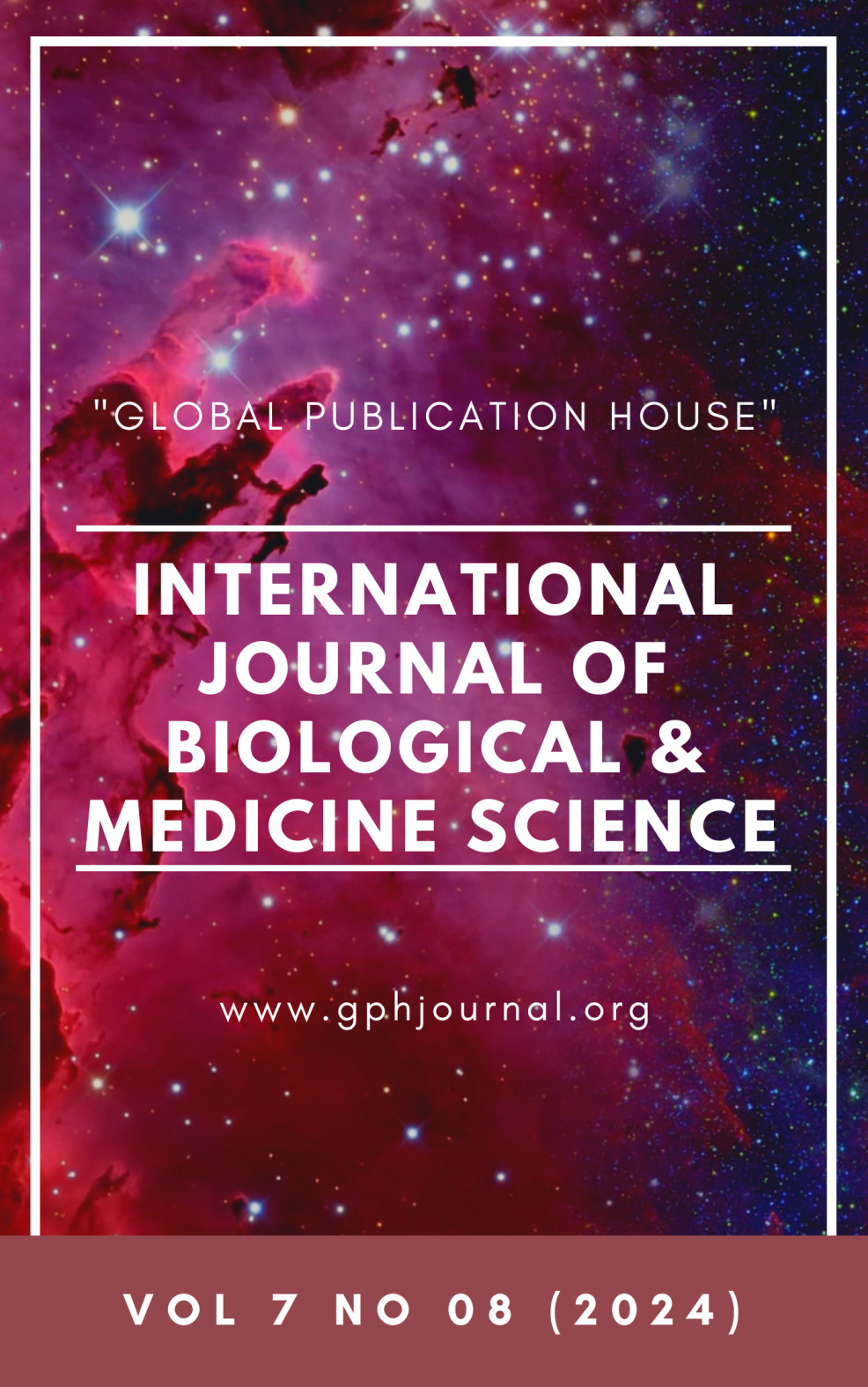PERIPARTUM VERTICAL TRANSMISSION OF HIV: A COMPARATIVE STUDY OF WOMEN WITH PRIOR ARV EXPOSURE AND ARV-NAÏVE WOMEN
Abstract
Background: The prevention of mother-to-child transmission (PMTCT) of HIV remains a public health challenge, particularly in resource-limited settings. This study aimed to compare the rates of vertical transmission among HIV-positive pregnant women with prior antiretroviral (ARV) exposure and those who were ARV-naïve.Methods: This prospective cohort study was conducted in four hospitals in Jos, Nigeria. A total of 131 HIV-positive pregnant women were recruited, categorized into an exposed group (prior ARV exposure) and an unexposed group (ARV-naïve). Data were collected on demographic characteristics, ARV regimen, maternal viral load and infant outcomes. Polymerase chain reaction (PCR) testing was utilized to determine HIV status in infants. The data was analysed using SPSS version 17. Descriptive statistics was used; continuous variables were summarized with mean, while discrete variables were summarized with numbers and percentages.Results: The study found a maternal-to-child transmission rate of 3.23%, significantly lower than the national average. The exposed group exhibited a transmission rate of 1.6%, compared to 4.9% in the unexposed group. The majority of subjects in both groups were of low parity and below 30 years of age. Furthermore, 98.38% of subjects in the index pregnancy received combined triple ARV therapy.Conclusion: The findings underscore the effectiveness of HAART in reducing vertical transmission rates. While the study highlights the importance of ARV adherence, further research is necessary to address limitations related to sample size and population representation, ensuring broader applicability of the results. Enhanced access to PMTCT programs is essential for improving maternal and infant health outcomes in Nigeria.
Downloads
References
Amin, O. et al. (2021) ‘Understanding viral and immune interplay during vertical transmission of HIV: implications for cure’, Frontiers in Immunology, 12, p. 757400.
Arora, D., Gupta, R.M. and Kochar, S.P.S. (2014) ‘Efficacy of single dose Nevirapine in reducing viral load in HIV positive mother in labour and transmission of HIV infection to new born babies as part of prevention of parent to child transmission’, medical journal armed forces india, 70(4), pp. 309–314.
Aulicino, P.C. et al. (2019) ‘Pre-treatment drug resistance and HIV-1 subtypes in infants from Argentina with and without exposure to antiretroviral drugs for prevention of mother-to-child transmission’, Journal of Antimicrobial Chemotherapy, 74(3), pp. 722–730.
Aziz, N. et al. (2013) ‘Time to viral load suppression in antiretroviral‐naive and ‐experienced HIV ‐infected pregnant women on highly active antiretroviral therapy: implications for pregnant women presenting late in gestation’, BJOG: An International Journal of Obstetrics & Gynaecology, 120(12), pp. 1534–1547. Available at: https://doi.org/10.1111/1471-0528.12226.
Cardenas, M.C. et al. (2023) ‘Prevention of the Vertical Transmission of HIV; A Recap of the Journey so Far’, Viruses, 15(4), p. 849.
Deya, B. (2022) ‘ART Adherence challenges faced by HIV-positive women in the Prevention of Mother-to Child Transmission of HIV in sub-Saharan AfricaA meta-synthesisAuthor: Belinda Deya’. Available at: https://www.diva-portal.org/smash/get/diva2:1678215/FULLTEXT02 (Accessed: 29 September 2024).
van Dijk, J. (2013) ‘Rural Realities in Pediatric HIV Service Delivery’. Available at: https://repub.eur.nl/pub/50079/ (Accessed: 29 September 2024).
Eholié, S.P. et al. (2016) ‘Antiretroviral treatment regardless of CD4 count: the universal answer to a contextual question’, AIDS Research and Therapy, 13(1), p. 27. Available at: https://doi.org/10.1186/s12981-016-0111-1.
ENIOLA, O.A.A. (2017) EPIDEMIOLOGY OF HIV/AIDS. PhD Thesis. Eastern Mediterranean University. Available at: https://www.researchgate.net/profile/Aishat-Okunuga/publication/379893072_EPIDEMIOLOGY_OF_HIVAIDS/links/66201b1666ba7e2359e605ad/EPIDEMIOLOGY-OF-HIV-AIDS.pdf (Accessed: 29 September 2024).
Fassinou, L.C. et al. (2024) ‘Adherence to option B + antiretroviral therapy and associated factors in pregnant and breastfeeding women in Sub-Saharan Africa: a systematic review and meta-analysis’, BMC Public Health, 24(1), p. 94. Available at: https://doi.org/10.1186/s12889-023-17004-9.
Haberer, J.E. et al. (2017) ‘Improving antiretroviral therapy adherence in resource-limited settings at scale: a discussion of interventions and recommendations’, African Journal of Reproduction and Gynaecological Endoscopy, 20(1). Available at: https://journals.lww.com/jrge/fulltext/2017/20010/Improving_antiretroviral_therapy_adherence_in.16.aspx (Accessed: 29 September 2024).
Karunarathna, I. et al. (2024) ‘Perinatal HIV transmission: Challenges and strategies in surgical management’. Retrieved from ResearchGate. Available at: https://www.researchgate.net/profile/Indunil-Karunarathna/publication/381846872_Perinatal_HIV_Transmission_Challenges_and_Strategies_in_Surgical_Management/links/66819d54f3b61c4e2ca0db15/Perinatal-HIV-Transmission-Challenges-and-Strategies-in-Surgical-Management.pdf (Accessed: 29 September 2024).
Lehman, D.A. et al. (2009) ‘Lower risk of resistance after short-course HAART compared with zidovudine/single-dose nevirapine used for prevention of HIV-1 mother-to-child transmission’, JAIDS Journal of Acquired Immune Deficiency Syndromes, 51(5), pp. 522–529.
Lima, V.D. et al. (2015) ‘Initiation of antiretroviral therapy at high CD4+ cell counts is associated with positive treatment outcomes’, Aids, 29(14), pp. 1871–1882.
Martinson, N.A. et al. (2009) ‘Women exposed to single-dose nevirapine in successive pregnancies: effectiveness and nonnucleoside reverse transcriptase inhibitor resistance’, Aids, 23(7), pp. 809–816.
Money, D. et al. (2014) ‘Guidelines for the care of pregnant women living with HIV and interventions to reduce perinatal transmission: executive summary’, Journal of obstetrics and gynaecology Canada, 36(8), pp. 721–734.
Mutihir, J.T. and Eka, P.O. (2011) ‘Stillbirths at the Jos University Teaching Hospital: incidence, risk, and etiological factors’, Nigerian journal of clinical practice, 14(1). Available at: https://www.ajol.info/index.php/njcp/article/view/65711/53399 (Accessed: 29 September 2024).
Ogbo, F.A. (2016) Infant and young child feeding practices in Nigeria: epidemiology and policy implications. PhD Thesis. Western Sydney University (Australia). Available at: https://search.proquest.com/openview/e0cec5cb6b387257c453572edbc73510/1.pdf?pq-origsite=gscholar&cbl=2026366&diss=y (Accessed: 29 September 2024).
Olakunde, B.O. et al. (2019) ‘Towards the elimination of mother-to-child transmission of HIV in Nigeria: a health system perspective of the achievements and challenges’, International health, 11(4), pp. 240–249.
Organization, W.H. (2016) Screening, assessment and management of neonates and infants with complications associated with Zika virus exposure in utero: rapid advice guideline. World Health Organization. Available at: https://apps.who.int/iris/bitstream/handle/10665/204475/WHO?sequence=1 (Accessed: 29 September 2024).
Persons, W.M. (1921) ‘Fisher’s formula for index numbers’, The Review of Economic Statistics, pp. 103–113.
Sambo, T.T. et al. (2023) ‘HIV In Pregnancy and Feto-Maternal Outcome’, J of Clini Epi & Public Health 1 (4), 01, 6. Available at: https://mkscienceset.com/articles_file/279-_article1700731044.pdf (Accessed: 29 September 2024).
Solanke, B.L. (2021) ‘Household wealth, decision-making, and high-parity pregnancies in Nigeria’, Women’s Reproductive Health, 8(1), pp. 44–59.
Thorne, C. and Newell, M.-L. (2003) ‘Mother-to-child transmission of HIV infection and its prevention’, Current HIV research, 1(4), pp. 447–462.
Tukur, J., Galadanci, H. and Adeleke, S.I. (2007) ‘Outcome of delivery among HIV positive mothers at Aminu Kano Teaching Hospital’, Nigerian Journal of Medicine, 16(1), pp. 34–37.
Vreeman, R. and Scanlon (2013) ‘Current strategies for improving access and adherence to antiretroviral therapies in resource-limited settings’, HIV/AIDS - Research and Palliative Care, p. 1. Available at: https://doi.org/10.2147/HIV.S28912.
Author(s) and co-author(s) jointly and severally represent and warrant that the Article is original with the author(s) and does not infringe any copyright or violate any other right of any third parties, and that the Article has not been published elsewhere. Author(s) agree to the terms that the GPH Journal will have the full right to remove the published article on any misconduct found in the published article.























